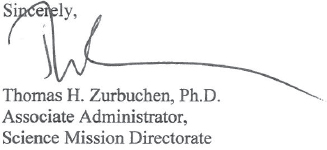A
Original Request from NASA

MAY, 19 2017
Reply to Attn of: Science Mission Directorate
Dr. Fiona Harrison Chair, Space Studies Board
National Academies of Sciences, Engineering, and Medicine 500 5th Street, NW Washington, DC 20001
Dear Dr. Harrison:
In accordance with international treaty obligations, NASA maintains a planetary protection policy to avoid biological contamination of other worlds, as well as to avoid the potential for harmful effects on the Earth due to the return of extraterrestrial materials by spaceflight missions. NASA Policy Directive 8020.7 requires that planetary protection requirements be based on recommendations from both internal and external advisory groups, but most notably the Space Studies Board (SSB). NASA relies on the Board—s ability to synthesize input from a wide spectrum of the science community and provide expert advice and recommendations, both as an advisory body and as the U.S. representative to the International Council for Science—s Committee on Space Research (COSPAR), which is consultative to the United Nations Committee on the Peaceful Uses of Outer Space. As such, the SSB—s recommendations on planetary protection are internationally recognized as authoritative and independent of NASA.
Planetary protection requirements for each mission and target body depend upon the type of encounter it will have (e.g., flyby, orbiter, or lander) and the nature of its destination (e.g., a planet, moon, comet, or asteroid). If the target body has the potential to provide clues about the origins and evolution of life or prebiotic chemical evolution, a spacecraft going there must meet a higher level of cleanliness, and some operating restrictions will be imposed. Spacecraft going to target bodies with the potential to support Earth life must undergo stringent cleaning and bioload-reduction processes, and may be subject to greater operating restrictions.
Current COSPAR planetary protection policy does not specify the status of sample return missions from Phobos or Deimos, the moons of Mars. Although the moons themselves are not considered potential habitats for life, recent modeling studies, that were supported by the NASA Planetary Protection Officer in coordination with the ESA Planetary Protection Officer under the ESA-NASA Letter of Agreement on Planetary Protection, indicate that a significant amount of material recently ejected from Mars could be present on the surface of Phobos.
Following this work, ESA issued a contract to perform additional modeling and tests to assess the extent to which post-ejection environmental conditions might inactivate potential Mars life transported to Phobos and Deimos in recent ejecta. The tests included hypervelocity impact inactivation of relevant Earth organisms, as well as ionizing radiation and heat.
Multiple space agencies, including NASA, are developing plans for bringing samples of material from Phobos or Deimos, which need to receive a planetary protection categorization of either Restricted or Unrestricted Earth Return. A designation of Restricted Earth Return, per NASA, ESA, and COSPAR policy, would require samples to be maintained in high containment and undergo a biohazard test protocol after return. In addition, the moons of Mars are targets for future human exploration, so an understanding of the potential for life from Mars to persist is relevant to assuring astronaut safety on those missions.
Furthermore, the European Space Agency (ESA) has ambitious plans for future Mars exploration missions, as does the Japanese Space Agency (JAXA). It is our understanding that ESA has requested the European Science Foundation (ESF) conduct a very similar review of the results of the ESA-funded research, which would include independent Japanese experts supported by JAXA. Given the close working relationship between NASA and ESA, in general, and the Letter of Agreement on Planetary Protection, in particular, the National Academies should engage with ESF and perform a joint study responsive to the needs of both agencies. It is expected that a detailed scope and objectives Terms of Reference for the joint undertaking will be established by consultation between the National Academies and the ESF.
I would like to request that the National Academies establish an ad hoc committee to review the recent ESA-funded work on environments encountered by Mars ejecta during and after the process of deposition on Mars moons, in the context of previous modeling and current understanding of conditions relevant to inactivation of carbon-based life. A Statement of Task is enclosed. The resulting report from the review shall include recommendations for an update of the planetary protection requirements for sample return from Phobos and/or Deimos.
Once agreement on the scope, cost, and schedule for the proposed study has been achieved, the Contracting Officer will issue a task order for implementation. Dr. Catharine A. Conley, Planetary Protection Officer, will be the technical point of contact for this effort and may be reached at cassie.conley@nasa.gov or (202) 358-3912.



